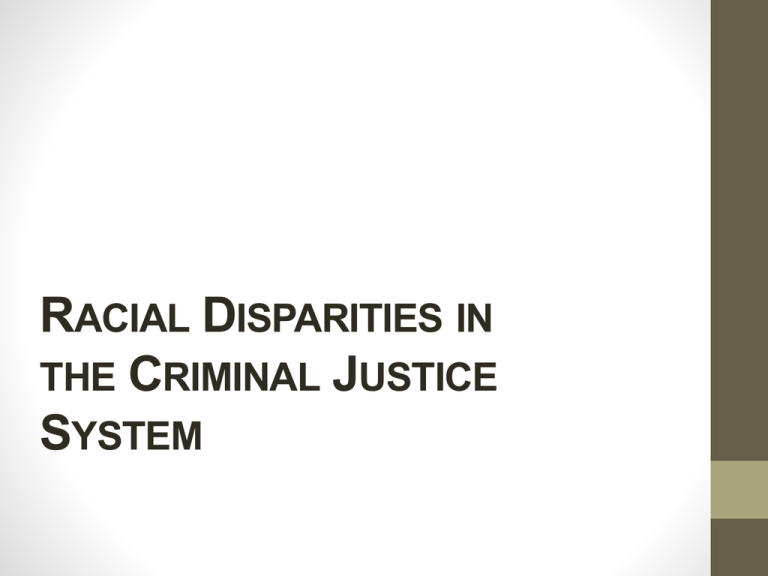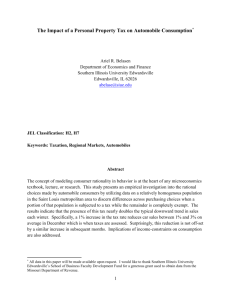Racial Disparities in the Criminal Justice System
advertisement

RACIAL DISPARITIES IN THE CRIMINAL JUSTICE SYSTEM Relative Rate Index (RRI) Minority Rate White Rate =1 No Disparities >1 Disparities <1 Disparities Source: 22nd Judicial Circuit of Missouri The System Overview Youth Population Referral to Juvenile Court Informal Adjustment Detention Cases Petitioned (Charges Filed) Transferred to Adult Criminal Court Delinquent Finding (Adjudicated)) Probation Supervision Out of Home Placement DYS Commitment Source: 22nd Judicial Circuit of Missouri Relative Rate Index concerning African Americans throughout the Juvenile Justice System 8 7.6 7 6 5 St. Louis 4 National [2009] 3 2 1 1.98 0.91 1.81 1.08 1.04 0.62 0.99 0.73 0 Source: National Center for Juvenile Justice Source: 22nd Judicial Circuit of Missouri Theories of Disparity Origin Differential Involvement Differential Selection and Processing Minorities commit more crimes Specifically, crimes that lead further into the system Police behavior and discrimination within the courts and corrections lead to disparities Cause Social Cause Bias Historical patterns of inequality Crime policies Discretion Support Both official data and self-reports demonstrate African Americans and some Support Hispanics disproportionately committing A study by Irving Piliavin and Scott Briar serious violent crimes determined that (1) an officer's discretion, (2) the juvenile's prior record, and (3) an African American's tendency towards a negative demeanor characterized juvenilepolice street interaction Mixed Method Differential involvement, important earlier on, causes initial contact with police, and thus influences differential selection later on Source: Disproportionate Minority Contact Disparity Index Demographic Disparity Index White 0.95 (-0.05) Black 1.62 (+0.62) Hispanic 0.81 (-0.19) Asian 0.55 (-0.45) American Indian 0.17 (-0.83) Other 0.54 (-0.46) Source: Missouri Vehicle Stops Report 2009 Vehicle Stops (Disparity Index) Source: Missouri Vehicle Stops Report Arrests in St. Louis Neighborhood with highest amount of crimes in September 2012: Downtown with 1015 crimes Crime committed the most: larceny with 697 reports 2 murders 5 rapes 70 robberies 109 aggravated assault 2 arsons Data Provided by St. Louis Metropolitan Police Department Murder: The willful killing of one human being by another. Manslaughter by negligence: The killing of another person through gross negligence. Negligence: A failure to exercise the standard of care that a reasonable person would exercise in a similar circumstance. Forcible Rape: The carnal knowledge of a female body forcibly and against her will. Data Provided by Metropolitan Police Department City of Saint Louis Robbery: The taking or attempting to take anything of value from the care ,custody, or control of a person or persons by force or threat of force or violence and/or by putting the victim in fear. Aggravated assault: An unlawful attack by one person on another for the purpose of inflicting severe or aggravated, bodily injury. Data Provided by Metropolitan Police Department City of Saint Louis Burglary: The unlawful entry of a structure to commit a felony or theft. Larceny-theft: The unlawful taking, carrying, leading, or riding away of property from the possession of another. Data Provided by Metropolitan Police Department City of Saint Louis Arson: Any willful or malicious burning or attempt to burn, with or without intent to defraud, a dwelling house, public building, motor vehicle or aircraft, personal property of another, and the like. Data Provided by Metropolitan Police Department City of Saint Louis Offenses concerning drug and alcohol violation include the possession, use, and sale of these substances. Some drugs are outlawed or can only be used when prescribed by a physician. Data Provided by Metropolitan Police Department City of Saint Louis Prostitution: The participation, or offering to participate, in sexual activity for a fee. Data Provided by Metropolitan Police Department City of Saint Louis Officers by Race and Gender Race White Black Other Total Male 55.22% 27.04% 2.22% 84.48% Female 9.23% 6.15% 0.14% 15.52% Total 64.45% 33.19% 2.36% 100% Data Provided by Metropolitan Police Department City of Saint Louis Convictions: What the Data Shows African Americans are about 11 times more likely to be convicted of murder in Missouri than other races. Data Provided by the Missouri Sentencing Advisory Commission Conviction Data for Other Crimes In Missouri Sentencing Differences Between Courts (2009) Prison sentences as a percentage of all sentences: The range is from 48.8% for circuit 18 (Cooper and Pettis counties) down to 10.8% for circuit 2 (Adair, Knox, and Lewis). The average percentage is 25.6. Shock and Treatment as a percentage of Prison and Shock and Treatment Sentences: The range is from 58.8% for circuit 2 (Adair, Knox, and Lewis) down to 10.6% for circuit 44 (Douglas, Ozark, and Wright counties). The average percentage is 29.0. Average Prison Sentences: St. Louis City has the highest average prison sentence with 9.0 years. Circuit 41 (Macon and Shelby), Circuit 1 (Clark, Schuyler, and Scotland), Circuit 39 (Barry, Lawrence, and Stone), Circuit 37 (Carter, Howell, Oregon, and Shannon), and Circuit 30 (Benton, Dallas, Hickory, Polk, and Webster) have the lowest average sentence with 4.5 years. Data Provided by Missouri Sentencing Advisory Commission Sentencing Disparity by Race (2009) A significant indicator of sentencing disparity by race is the incarceration rate in relation to the respective populations of Blacks, Hispanics, and other races. The MO incarceration rate for Blacks is over 5.5 times that of other races. Nationally, the Black rate is over 6.5 times the White incarceration rate. The incarceration rate for Hispanics in MO is lower than for other races and is only half the national rate for Hispanics. Blacks have the highest average prison sentence, 7.9 years compared to an average 5.9 years for Whites. Hispanics have the highest percentage of prison sentences (34.8%) and Whites have the highest percentage of probation sentences (64.5%). Data Provided by Missouri Sentencing Advisory Commission









